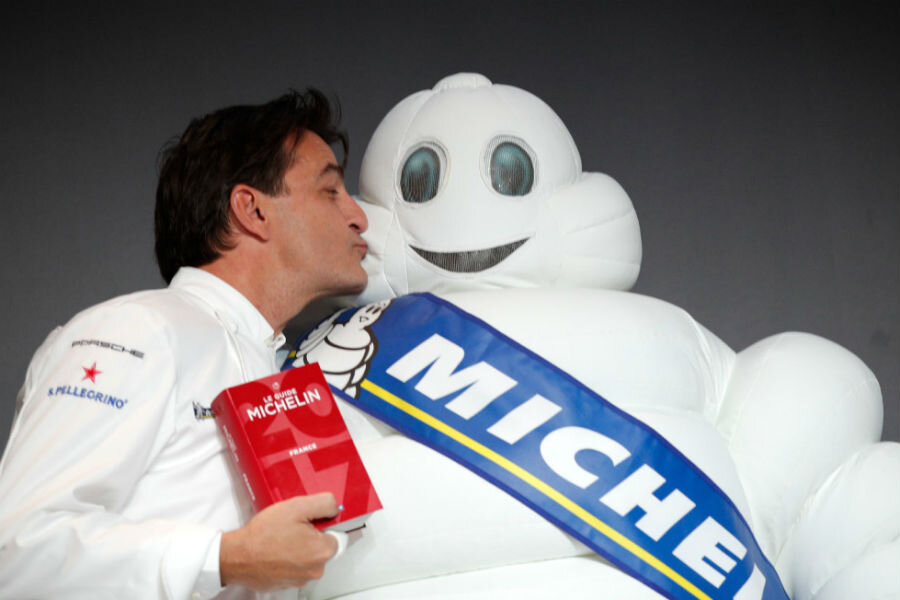Bouche à Oreille: Michelin mixup makes modest French café a star
Loading...
Michelin. The name has become synonymous with fine dining (and tires). And if a recent mix-up is any indication, it still exerts tremendous pull for gourmands near and far.
Last week, Bouche à Oreille, a café in Bourges, central France, found itself suddenly in possession of a Michelin star. The eatery, which serves hearty dishes of beef bourguignon and lasagna to its clientele of locals, was taken aback by the arrival of swarms of new visitors.
“Suddenly, we were rushed off our feet,” café owner Véronique Jacquet told The Telegraph. “Reporters were coming in … I had regulars and friends phoning up and asking why I hadn’t told them we’d won a Michelin star.”
But the star, it turned out, had actually been intended for a different Bouche à Oreille – an upscale Paris restaurant that offers dishes like calf’s head and lobster flan. Thanks to their identical names, and eerily similar street addresses, the Michelin website had listed the Bourges café on its website by mistake. (The error did not appear in the print Michelin guide or on the mobile app.) In the two days it took to correct the mistake, diners from near and far had flocked to Bourges.
Though the two proprietors took the mixup in stride, reportedly sharing their amusement in a phone call, the Michelin ratings are no laughing matter for many chefs and foodies. That’s particularly true in France, where brothers André and Edouard Michelin founded the guide in 1900. Originally intended for motorists, it became a gourmand’s Bible, making Michelin stars a holy grail of sorts for aspiring top chefs.
As the case of Bouche à Oreille demonstrated, a star can make a tremendous difference to an establishment’s popularity.
“When you get your first star, your second star, your third star, your life changes, your customer base changes,” Michael Ellis, the international director of Michelin guides, told Vanity Fair in 2015.
Michelin ratings focus on food, but also take a restaurant’s atmosphere into account. With that in mind, some French chefs concerned about maintaining their ratings have begun to crack down on the phenomenon of photographing restaurant food. Heavy social media use, they told The Christian Science Monitor, negatively impacts the ambiance and interferes with the traditional French dining experience, which UNESCO in 2010 named one of the intangibles of world cultural heritage.
The photos themselves may also sway critics – and not for the better, chefs worry.
“The photos are not professional, have terrible lighting, and make the food look bad,” François Pasteau, chef at Epi Dupin, a Michelin-starred restaurant in Paris, told the Monitor. “They go onto the Internet and stay there forever. This can contribute to a poor critique of the restaurant.”
Though gourmet remains the name of the game in France, American influence is growing. On the streets of Paris, chefs prepare everything from burgers to artisanal tacos. Tastes are changing in restaurants, too, Monitor correspondent Sara Miller Llana observed in 2014:
“At a very trendy bistro, where my husband and I ordered the very French formule midi – appetizer, main dish, and dessert for lunch – I did notice everyone else had ordered the cheeseburger. And they were paying 20 euros ($27) for it.”
The evolution has raised the question: Can Michelin keep up? To critics, Michelin’s army of full-time anonymous testers place too much emphasis on consistency and traditional French presentation, which they complain can lead to staid predictability.
“It’s basically robotic cuisine; they cannot afford to change, because that was the winning formula,” chef Daniel Boulud told Vanity Fair. His restaurant, Daniel, lost one of its 3 stars in 2014 for a perceived lack of consistency. “Emotionally, I’m going to want to cook something else than what I’ve done.”
Bourges’ Bouche à Oreille may never win a star in its own right. But heart – which Penelope Salmon, the café’s cook, identified as the key to her dishes – may play a growing role in Michelin’s formula. In 2016, the Michelin guide awarded a star to two Singaporean street food stalls, where a meal costs around $2.
“In terms of the quality of the ingredients, in terms of the flavors, in terms of the cooking techniques, in terms of just the general emotions, that they are able to put in their dishes ... that is something that I think is really unique to Singapore,” Mr. Ellis said, according to PRI.








